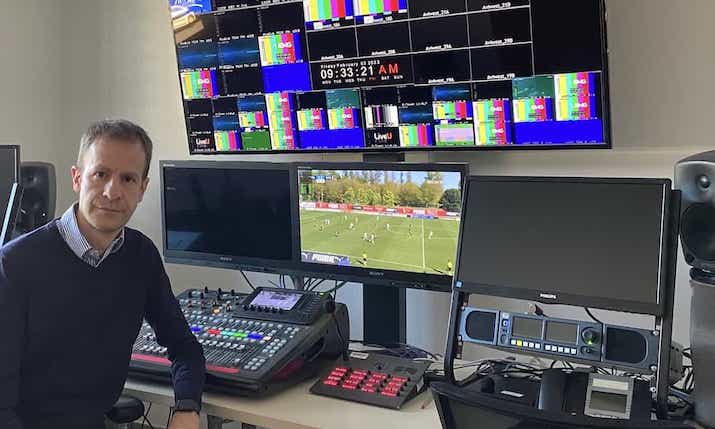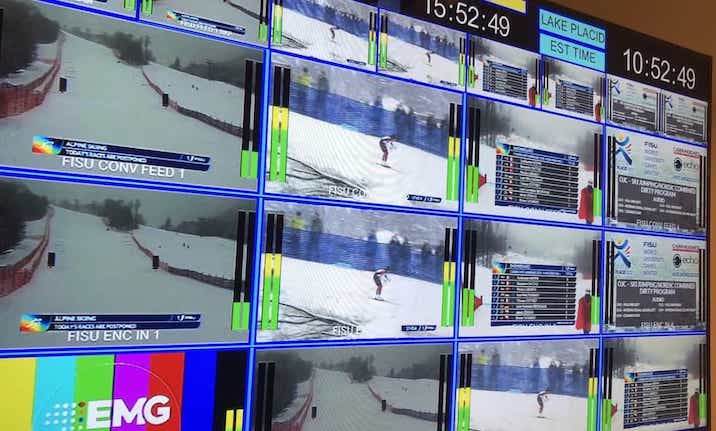Flexible and futureproof: Behind the scenes at EMG Italy’s new FISU broadcast operation hub

Luca Bertoldi, technical department manager of EMG Italy for the FISU project
Founded in 1949, FISU, the International Federation of University Sports, was created to spread the values of sport in the university world. It is also responsible for the organisation and governance of worldwide sports competitions for student-athletes between the ages of 17 and 25, including the World University Games.
The winter 2023 edition of the FISU World University Games took place in Lake Placid, New York State, from 12-22 January and involved over 2,500 athletes, coaches, judges and referees from 50 countries. Twelve sports were showcased at the event, which combines high-level sports with educational and cultural moments across 10 different sites and almost 100 competitions and exhibitions.
The latest edition of the games also saw EMG Italy’s new broadcast operation hub for FISU called into action. EMG Italy has designed and implemented an innovative master control room (MCR) inside its Cologno Monzese production centre entirely dedicated to FISU. It was created in collaboration with SES, a leader in connectivity solutions, and EVS for the international distribution of signals.
The new space enables the control and distribution of live channel streaming and also the management and creation of content on a cloud platform for rightsholders and takers from all over the world.
The set up
Starting from the various sites around Lake Placid where the sporting competitions were held, four international host broadcast feeds and related backup feeds were packaged and then sent via the internet using the SRT protocol to the production centre.
The operations centre on the outskirts of Milan and the dedicated MCR, therefore, acted as a hub for the reception and subsequent distribution of all signals to Europe, East Asia, South America, Africa and Oceania.

“On this occasion”, says Luca Bertoldi, technical department manager of EMG Italy for the FISU project, “we were asked to manage four redundant program signals, together with four other backup feeds, but we are ready to handle even more. All the signals have travelled from the US up to us on the public internet, through two different service providers and through the SRT protocol, which carries signals in H.264 and H.265. All this has allowed us to receive an excellent low latency compressed stream that we have easily conveyed over the internet.
“We chose the SRT protocol because it would have been impossible for us to use dedicated fibre optic lines directly from Lake Placid. Otherwise, we would have had to use satellite links with higher costs.”
Live distribution and content management
EMG Italy’s production centre has a series of master control rooms of different sizes for added flexibility. During the FISU Games, the four signals arriving from the US deliver images of four different disciplines taking place at the same time and enter a matrix which allows switching in order to decide what to broadcast.
An hour before the broadcast, the MCR receives alignment signals that allow it to verify the sychronisation between the audio and video to be ready for the next broadcast. The signal is also recorded simultaneously on EVS MediaHub devices which make it possible to upload live video streams to the cloud.
These contributions are made instantly available to rightsholders as the signals themselves are recorded, while ‘near live’ mode allows editing stations to package the highlights without delay.
The MCR directly provides for the delivery and distribution of the live signals and, again using the SRT protocol, enables content to reach multiple destinations simultaneously by relying on a cloud platform.
Bertoldi continues: “The four signals arriving from Lake Placid enter four SRT decoder receivers which take care of the conversion to SDI, then they continue in the matrix and at the same time they are displayed on multiview screens.
“This visual check allows one to choose which signals to send to the two main destinations: one is the delivery platform to EVS MediaHub, created using a special encoder; the other destination is delivery to the takers, which is managed through various coding systems: a first main coding generates a flow, thanks to the encoders, which allow the signal to be delivered to a cloud platform.”
He continues: “From here the signal is forwarded to all destinations without limiting the number of flows we can send. Therefore, the choice of cloud operation is linked to scalability, which in this case becomes practically infinite. If we had had to carry out the distribution directly from the production centre, it would have been essential to have sufficient bandwidth to manage all the flows and would require many dedicated high-performance encoders.
“The cloud platform allows us to generate a main and a backup stream which we then distribute to all takers, while still maintaining control over every single connection. Such an operation enables us to have a dedicated profile for each taker, with its own IP address and with the same encryption.”
A versatile master control room
The MCR that EMG Italy has dedicated to FISU is designed to be versatile and to easily adapt to every need that will arise from the federation in the coming years.
In addition to featuring distributed co-ordination systems useful in real-time interactions with event venues, it can also be integrated with commentary booths for localisation in various languages, and in-situ workstations for highlight editing, which in this case weren’t necessary.
“Furthermore, distribution on the public internet,” concludes Bertoldi, “allows the entire process of managing contributions and distribution to be more efficient. SRT is an open source standard protocol that allows the creation of low latency video streams with good error correction.”
“We are very pleased with the results of this project,” says Dominique Curchod, head of television at FISU. “When you are responsible for distributing an event, you tend to favour security over technological evolution: moving from a full satellite to entirely SRT was a complex challenge. Three factors drove us to go ahead: first of all, the SRT system has more advantageous costs than the satellite; then, after using the RTMP system for almost six years, we have verified and tested the stability of the public internet around the world, especially the crucial points of the outgoing and incoming connections. Finally, the existing technology at EMG Italy, which has also been in operation for several years, and the conditions offered were more than enough to convince us.”

